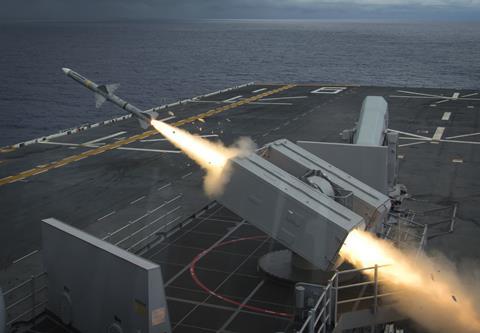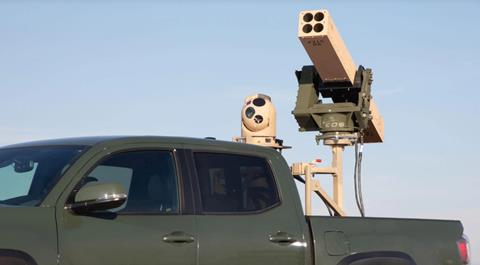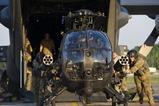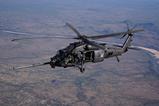Defence technology manufacturer L3Harris is exploring a maritime version of the company’s Vampire counter-drone weapon system to defend ships from airborne threats.
Originally conceived as a truck-mounted platform offering low-cost precision defence for ground forces, the Vampire gained prominence in 2022 as one of the early weapon systems provided to Ukraine by the Pentagon.
Simple and rugged by design, Vampires pair the widely-available BAE Systems Advanced Precision Kill Weapon Systems (APKWS) 2.75mm rocket with an L3Harris Wescam MX-10D digital sensor and laser designator.
Now, L3Harris says it is adapting the Vampire into a package that could offer a counter-UAS solution to ships at sea.
“We’re actually doing demonstrations for maritime use currently,” says Jason Lambert, president of intelligence, surveillance and reconnaissance for L3Harris. “We have a version that we’re actually deploying on the back of a ship.”
Lambert spoke to FlightGlobal on 17 September at the annual Air & Space Forces Association (AFA) conference near Washington, DC.

US naval ships have come under repeated bombardment by cruise missiles and one-way UAS weapons in the Red Sea over the past year. Pentagon officials have described the fighting as the US Navy’s (USN’s) heaviest combat since World War II.
While combat ships boast highly-capable, multi-layer air defences, those systems primarily involve large, expensive missiles – and ships can carry only limited quantities. Radar-guided cannons are a last line of close-in defence.
Each of the USN’s Raytheon SM-2 air defence missiles costs roughly $2 million, while the larger SM-6 costs more than $4 million, according to the Center for Strategic and International Studies.
By contrast, the APKWS rockets fired by the Vampire system are small and cheap, offering an appealing intermediate option between long-range missiles and close-range guns.
“That small-scale size gives a really good price point per shot,” Lambert notes.

While installing a Vampire shipboard is one option being looked at by L3Harris, the company is also exploring using smaller unmanned ships to host the weapon system. These would form a perimeter around the target ship, creating a bubble of anti-drone protection.
“Think of vehicles out in front of the main vessel with the APKWS and the Vampire system,” Lambert says.
He suggests four such uncrewed vessels, complete with plentiful stores of rockets, could be deployed by a single naval ship to provide an extra layer of protection.
Human operators located on the main ship would control the remote Vampire systems, targeting threats and guiding the rockets. L3Harris is also exploring the incorporation of autonomy into the system, particularly for target identification.
While the Vampire ground system deployed in Ukraine uses a smaller four-round magazine of APKWS rockets, Lambert says the maritime concept would carry more rockets.
The Pentagon says attacks against USN ships in the past year have included dozens of one-way UAS munitions fired in saturation-style waves. These have been defeated by ship-based air defences and intercepted by carrier-launched fighters.
Despite those efforts, multiple civilian ships have been struck, with at least one sinking.
L3Harris has already made several improvements to the Vampire since its deployment to Ukraine, including the use of proximity fuses on APKWS rockets, which eliminates the need to directly hit targets.
Lambert says the company has received “incredibly positive” feedback from Ukraine related to the system’s battlefield performance.
Drone warfare has emerged as the signature style of combat in the bloody, protracted war. Both sides have made ample use of small quadcopters for reconnaissance, artillery spotting, anti-personnel and anti-armour strikes.
Russia has also fired mass waves of one-way UAS into Ukrainian population centres, along with conventional cruise missiles.





















































